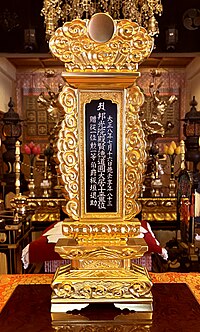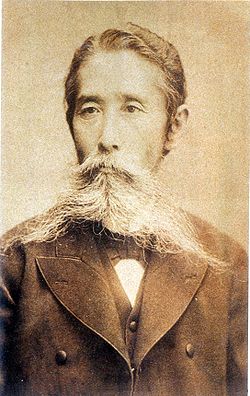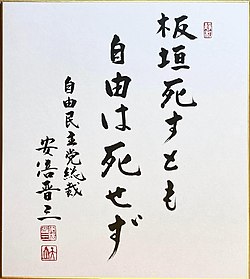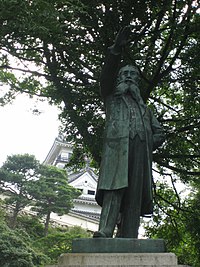| Junior First Rank CountItagaki Taisuke | |
|---|---|
| 板垣 退助 | |
 Taisuke Itagaki c. 1906 (69 years old.) Taisuke Itagaki c. 1906 (69 years old.) | |
| Born | (1837-05-21)May 21, 1837 Tosa Domain, Japan |
| Died | July 16, 1919(1919-07-16) (aged 82) Tokyo, Japan |
| Nationality | Japanese |
| Occupation(s) | Politician, Cabinet Minister |
Count Itagaki Taisuke (板垣 退助, 21 May 1837 – 16 July 1919) was a Japanese politician. He was a leader of the "Freedom and People's Rights Movement" and founded Japan's first political party, the Liberal Party.
Biography
Early life

Itagaki Taisuke was born into a middle-ranking samurai family in Tosa Domain, (present day Kōchi Prefecture), After studies in Kōchi and in Edo, he was appointed as sobayonin (councillor) to Tosa daimyō Yamauchi Toyoshige, and was in charge of accounts and military matters at the domain's Edo residence in 1861. He disagreed with the domain's official policy of kōbu gattai (reconciliation between the Imperial Court and the Tokugawa shogunate), and in 1867–1868, he met with Saigō Takamori of the Satsuma Domain, and agreed to pledge Tosa's forces in the effort to overthrow the shōgun in the upcoming Meiji Restoration. During the Boshin War, he emerged as the principal political figure from Tosa domain as a leader of the Jinshotai assault force, and claimed a place in the new Meiji government after the Tokugawa defeat.
Meiji statesman to liberal agitator
 Buddhist memorial tablet of Itagaki Taisuke (front side)
Buddhist memorial tablet of Itagaki Taisuke (front side) Buddhist memorial tablet of Itagaki Taisuke (back side) "Itagaki may die, but liberty never!"
Buddhist memorial tablet of Itagaki Taisuke (back side) "Itagaki may die, but liberty never!"

Itagaki was appointed a Councilor of State in 1869, and was involved in several key reforms, such as the abolition of the han system in 1871. As a sangi (councillor), he ran the government temporarily during the absence of the Iwakura Mission.

(Painted by Matsumoto Fūko, Calligraphy by Itagaki Taisuke)
However, Itagaki resigned from the Meiji government in 1873 over disagreement with the government's policy of restraint toward Korea (Seikanron) and, more generally, in opposition to the Chōshū-Satsuma domination of the new government.
In 1874, together with Gotō Shōjirō of Tosa and Etō Shinpei and Soejima Taneomi of Hizen, he formed the Aikoku Kōtō (Public Party of Patriots), declaring, "We, the thirty millions of people in Japan are all equally endowed with certain definite rights, among which are those of enjoying and defending life and liberty, acquiring and possessing property, and obtaining a livelihood and pursuing happiness. These rights are by Nature bestowed upon all men, and, therefore, cannot be taken away by the power of any man." This anti-government stance appealed to the discontented remnants of the samurai class and the rural aristocracy (who resented centralized taxation) and peasants (who were discontented with high prices and low wages). Itagaki's involvement in liberalism lent it political legitimacy in Japan, and he became a leader of the push for democratic reform.
Itagaki and his associations created a variety of organizations to fuse samurai ethos with western liberalism and to agitate for a national assembly, written constitution and limits to arbitrary exercise of power by the government. These included the Risshisha (Self-Help Movement) and the Aikokusha (Society of Patriots) in 1875. After funding issues led to initial stagnation, the Aikokusha was revived in 1878 and agitated with increasing success as part of the Freedom and People's Rights Movement. The Movement drew the ire of the government and its supporters.
Leadership of the Liberal Party


(Calligraphy by Abe Shinzo)


Government leaders met at the Osaka Conference of 1875, to which seven schools created under Itagaki's influence sent delegations, and the various delegates entered into an agreement by which they pledged themselves to the principle of a constitutional monarchy and a legislative assembly. They enticed Itagaki to return as a sangi (councilor): however, he resigned after a couple of months to oppose what he viewed as excessive concentration of power in the Genrōin. Itagaki criticized the government at the same time as it was under threat by the 1877 Satsuma Rebellion, which turned the cabinet against him. Legislation was then created restraining free speech and association.
In response, Itagaki created the Liberal Party (Jiyuto) together with Numa Morikazu in 1881, which, along with the Rikken Kaishintō, led the nationwide popular discontent of 1880–1884. During this period, a rift developed in the movement between the lower class members and the aristocratic leadership of the party. Itagaki became embroiled in controversy when he took a trip to Europe believed by many to have been funded by the government. The trip turned out to have been provided by the Mitsui Company, but suspicions that Itagaki was being won over to the government side persisted. Consequently, radical splinter groups proliferated, undermining the unity of the party and the Movement. Itagaki was offered the title of Count (Hakushaku) in 1884, as the new peerage system known as kazoku was formed, but he accepted only on the condition that the title not be passed on to his heirs. In 1882, Itagaki was almost assassinated by a right-wing militant, to whom he allegedly said, "Itagaki may die, but liberty never!"
The Liberal Party dissolved itself on 29 October 1884. It was reestablished shortly before the opening of the Imperial Diet in 1890 as the Rikken Jiyūtō.
In April 1896, Itagaki joined the second Itō administration as Home Minister. In 1898, Itagaki joined with Ōkuma Shigenobu of the Shimpotō to form the Kenseitō, and Japan's first party government. Ōkuma became Prime Minister, and Itagaki continued serving as Home Minister. The Cabinet collapsed after four months of squabbling between the factions, demonstrating the immaturity of parliamentary democracy at the time in Japan. Itagaki retired from public life in 1900 and spent the rest of his days writing. He died of natural causes in 1919.
After Liberal Party
In the Freedom and People's Rights Movement in Okinawa, Itagaki supported Jahana Noboru. In the Petition Movement for the Establishment of a Taiwanese Parliament, Itagaki and Lin Hsien-tang established The Taiwan Assimilation Society in 1914. Itagaki Taisuke was sympathetic to the colonial policy in Taiwan toward the Taiwanese people and insisted that the rights and treatment of Taiwanese be the same as those of the Japanese and that discrimination be eliminated.
Legacy

Itagaki is credited as being the first Japanese party leader and an important force for liberalism in Meiji Japan. His portrait has appeared on the 50-sen and 100-yen banknotes issued by the Bank of Japan.
Honors
From the corresponding article in the Japanese Misplaced Pages
Peerages
- Count (9 May 1887; life peerage)
Decorations
- Grand Cordon of the Order of the Rising Sun (29 September 1896)
- Grand Cordon of the Order of the Rising Sun with Paulownia Flowers (16 July 1919; posthumous)
Family crest of Itagaki clan

|

|

|
| Jigurobishi | Kayanouchi Jumonji | Tosa kiri |
Genealogy
- Inui family (Itagaki family) Their clan name is Minamoto(Seiwa-Genji).
In this house, Edo period was a samurai in the Tosa clan from generation to generation. Knight (senior samurai). Original Itagaki used "Jiguro-bishi (Kage-hanabishi)" for the family crest with Takeda of the effect for the same family. However, Inui used "Kayanouchi Jumonji" (Azuchi Period to Meiji Period), "Tosa Kiri" (Meiji Period to now).
| ∴ | |||||||||||||||||||||||||||||||||||||||||||||||||||||||||||||||||||||||||||||||||||||||||||
| Itagaki Kanenobu | |||||||||||||||||||||||||||||||||||||||||||||||||||||||||||||||||||||||||||||||||||||||||||
| Itagaki Yoritoki | Itagaki Yorishige | ||||||||||||||||||||||||||||||||||||||||||||||||||||||||||||||||||||||||||||||||||||||||||
| Itagaki Yorikane | Itagaki Nobuyori | Itagaki Sanekane | Takeda Nagakane | ||||||||||||||||||||||||||||||||||||||||||||||||||||||||||||||||||||||||||||||||||||||||
| Itagaki Yukiyori | Takeda Nobusada | ||||||||||||||||||||||||||||||||||||||||||||||||||||||||||||||||||||||||||||||||||||||||||
| Itagaki Nagayori | Nakamura Kanekuni | ||||||||||||||||||||||||||||||||||||||||||||||||||||||||||||||||||||||||||||||||||||||||||
| Itagaki Saburozaemon | Nakamura Kanesada | ||||||||||||||||||||||||||||||||||||||||||||||||||||||||||||||||||||||||||||||||||||||||||
| Itagaki Saburozaemon | Itagaki Shiro | ||||||||||||||||||||||||||||||||||||||||||||||||||||||||||||||||||||||||||||||||||||||||||
| Itagaki Kanemitsu | |||||||||||||||||||||||||||||||||||||||||||||||||||||||||||||||||||||||||||||||||||||||||||
| Itagaki Harimanokami | |||||||||||||||||||||||||||||||||||||||||||||||||||||||||||||||||||||||||||||||||||||||||||
| Itagaki Shokei | |||||||||||||||||||||||||||||||||||||||||||||||||||||||||||||||||||||||||||||||||||||||||||
| Itagaki Gan-ami | |||||||||||||||||||||||||||||||||||||||||||||||||||||||||||||||||||||||||||||||||||||||||||
| Itagaki Zenmanbo | |||||||||||||||||||||||||||||||||||||||||||||||||||||||||||||||||||||||||||||||||||||||||||
| Itagaki Bisyu | Itagaki Nobuyasu | ||||||||||||||||||||||||||||||||||||||||||||||||||||||||||||||||||||||||||||||||||||||||||
| Itagaki Hokinokami | Itagaki Nobukata | Morozumi Genbanojo | woman | ||||||||||||||||||||||||||||||||||||||||||||||||||||||||||||||||||||||||||||||||||||||||
| Itagaki Nobunori | Sakayori Masamitsu | Itagaki Nobuyasu | wife of Itagaki Nobuyasu | ||||||||||||||||||||||||||||||||||||||||||||||||||||||||||||||||||||||||||||||||||||||||
| Itagaki Masanobu | Itagaki Masatora | woman | Itagaki Surinosuke | Itagaki Hayato | |||||||||||||||||||||||||||||||||||||||||||||||||||||||||||||||||||||||||||||||||||||||
| Inui Masayuki | Itagaki Masayoshi | Sakayori Masayoshi | |||||||||||||||||||||||||||||||||||||||||||||||||||||||||||||||||||||||||||||||||||||||||
| Inui Masasuke | Inui Masanao | Inui Tomomasa | |||||||||||||||||||||||||||||||||||||||||||||||||||||||||||||||||||||||||||||||||||||||||
| Inui Masakata | Inui Jujiro | Inui Masafusa | Inui Muichi | ||||||||||||||||||||||||||||||||||||||||||||||||||||||||||||||||||||||||||||||||||||||||
| Inui Kasuke | Inui Masakiyo | wife of Kondo Michikata | Inui Jusuke | Inui Yoshikatsu | |||||||||||||||||||||||||||||||||||||||||||||||||||||||||||||||||||||||||||||||||||||||
| Inui Naotake | Inui Naokowa | Nakayama Hidenobu | Inui Kowamasa | Inui Masafusa | Inui Masanaru | ||||||||||||||||||||||||||||||||||||||||||||||||||||||||||||||||||||||||||||||||||||||
| Inui Masa-akira | Inui Masahisa | ||||||||||||||||||||||||||||||||||||||||||||||||||||||||||||||||||||||||||||||||||||||||||
| Inui Nobutake | Nomoto Nobuteru | woman | Inui Masaharu | Motoyama Shigeyoshi | |||||||||||||||||||||||||||||||||||||||||||||||||||||||||||||||||||||||||||||||||||||||
| Inui Masashige | wife of Hirai Masazane | wife of Nagaya Hikodayu | Inui Masakatsu | Inui Masa-atsu | Inui Masa-atsu | ||||||||||||||||||||||||||||||||||||||||||||||||||||||||||||||||||||||||||||||||||||||
| Itagaki Taisuke | Inui Kyuba | wife of Hino Shigeyoshi | woman | woman | Inui Seishi | ||||||||||||||||||||||||||||||||||||||||||||||||||||||||||||||||||||||||||||||||||||||
| Itagaki Hokotaro | Inui Seishi | Itagaki Magozaburo | Itagaki Masami | Inui Muichi | Kataoka Hyoko | Miyaji Gunko | Ogawa Enko | Asano Chiyoko | Oyama Ryoko | ||||||||||||||||||||||||||||||||||||||||||||||||||||||||||||||||||||||||||||||||||
| Itagaki Takeo | Itagaki Morimasa | Itagaki Masatsura | Kawase Miyoshi | Nakamura Choshi | Inui Ichiro | Miyaji Shigeaki | Motoyama Nobuko | Asano Kazuharu | Asano Fusako | Oyama Tomomitsu | |||||||||||||||||||||||||||||||||||||||||||||||||||||||||||||||||||||||||||||||||
| Ozaki Tadashi | Mishima Takuko | Itagaki Masa-aki | Akiyama Noriko | Itagaki Taitaro | Itagaki Naomaro | Kawase Katsuyo | Sugisaki Mitsuyo | Nakamura Junko | Takaoka Mariko | Oyama Tomokazu | |||||||||||||||||||||||||||||||||||||||||||||||||||||||||||||||||||||||||||||||||
| Ozaki Kimimasa | Akiyama Takeo | Akiyama Takeshi | Akiyama Yuri | Itagaki Yuko | Itagaki Akihiro | Nakamura Naotaka | Nakamura Kazutaka | Ibuka Mika | Takaoka Koutaro | Oyama Tomoaki | Oyama Tomohide | ||||||||||||||||||||||||||||||||||||||||||||||||||||||||||||||||||||||||||||||||
Source "Kai Kokushi". Matsudaira Sadayoshi. 1814. Japan.(Aduchi-Momoyama period part) "Kwansei-choshu Shokafu". Hotta Masaatsu, Hayashi jyussai. 1799. Japan.(Aduchi-Momoyama period part) "Osamuraichu Senzogaki-keizucho"(Edo period part)
Family
Notes
| This article includes a list of general references, but it lacks sufficient corresponding inline citations. Please help to improve this article by introducing more precise citations. (September 2020) (Learn how and when to remove this message) |
- ^ Chisholm 1911, p. 887.
- Chisholm 1911, pp. 887–888.
- Chisholm 1911, p. 888.
- Jansen, Marius (2000). The Making of Modern Japan, p. 381.
- Perceptions of the "Meiji Restoration" in Colonial Taiwan 1, yang su xia - Ritsumeikan University
- Tosa-han(official document) Japan(1826). Osamuraichu Senzogaki-keizucho. Kochi prefectural library, Japan.
- Takakuwa Komakichi, Yoda Kiichiro, Narikawa Eijiro. Koutei-zoho Azumakagami. Dainippontosho, Japan(1896).
- Taisuke Itagaki's grave. Sinagawa, Tokyo, Japan.
- 板垣信方の娘婿。実は於曾氏。永祿元年(1558年)、武田信玄の命に依って、板垣家を再興
- 永原一照次男
- 板垣退助五男、絶家再興
- 乾正春の養子となる
- 板垣退助次男
- 乾正厚の養子となる
- 乾友正家の絶家再興
References
- Beasley, William G. (1995). The Rise of Modern Japan: Political, Economic and Social Change Since 1850. New York: Martin's Press. ISBN 0-312-12751-0
- Chisholm, Hugh, ed. (1911). "Itagaki, Taisuke, Count" . Encyclopædia Britannica. Vol. 14 (11th ed.). Cambridge University Press. pp. 887–888.
- Jansen, Marius B. and Gilbert Rozman, eds. (1986). Japan in Transition: from Tokugawa to Meiji. Princeton: Princeton University Press. ISBN 9780691054599; OCLC 12311985
- Totten, George O. (compiled by). (1966). Democracy in Prewar Japan: Groundwork or Facade?. Boston: D.C. Heath and Company. OCLC 255863
- Itagaki Taisuke Honouring Association (2019). The Mind of Count Itagaki Taisuke. ISBN 978-4-86522-183 1 C0023
External links
- Draft letter of resignation from the Cabinet by Itagaki in 1898 Archived 2013-02-12 at the Wayback Machine
- National Diet Library biography & photo
| Political offices | ||
|---|---|---|
| Preceded byYoshikawa Akimasa | Home Minister 14 April 1896 – 20 September 1896 |
Succeeded byKabayama Sukenori |
| Preceded byYoshikawa Akimasa | Home Minister 30 June 1898 – 8 November 1898 |
Succeeded bySaigō Tsugumichi |
- 1837 births
- 1919 deaths
- Meiji Restoration
- Samurai
- Boshin War
- Japanese Buddhists
- Japanese military leaders
- Government ministers of Japan
- Kazoku
- Liberalism in Japan
- People of Meiji-era Japan
- People from Tosa Domain
- Aikoku Kōtō politicians
- Liberal Party (Japan, 1881) politicians
- Ministers of home affairs of Japan
- Politicians from Kōchi Prefecture
